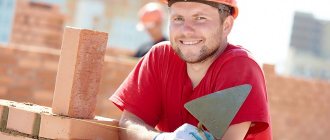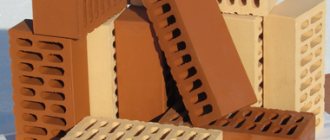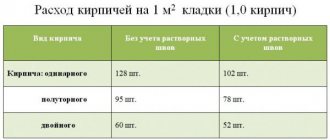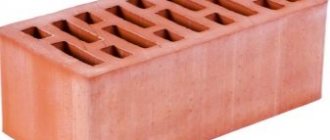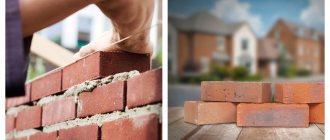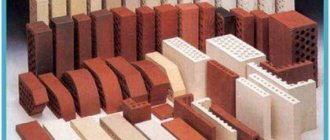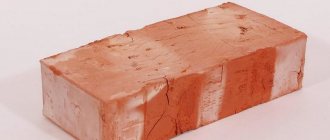Yellow ceramic products
The industry produces popular yellow ceramic finishing bricks not only in different colors, but also with different textures, different sizes and different styles.
And if the project includes arches, columns or supports, then additional decorative elements simplify the installation process. The raw material for ceramic products is fine-grained clay with a particle diameter of no more than 0.005 mm. Clay may contain several minerals or one from the kaolinite group; it may also contain both sand and carbonate particles.
Fine-grained clay softened with water.
The main chemical part of clay-forming minerals is:
- Aluminum oxide Al2O3.
- Silicon oxide SiO2.
Ceramic yellow products are obtained from kaolin and additives that determine the color. Very few such additives are needed, so yellow facing material is considered environmentally friendly.
Manufacturing methods
- Volumetric. With this method, a coloring ingredient, such as manganese oxide, is introduced into the clay. After thorough mixing, bricks are formed, followed by firing. You can get different shades by adjusting the firing temperature and time. If light-colored products are required, a clarifier is added to the raw material, which can give a straw color. This technology makes it possible to obtain a uniform color over the entire area of the product.
- Surface painting - with this method, a colored layer is applied only to the dried area of the product, and then fired. In this case, liquid white clay containing coloring pigments is used for coloring. This method produces coloring to a product depth of up to 2 – 3 mm.
Decorative facing brick painted yellow.
Types of ceramic bricks
- Angobed products with a decorative layer applied. Its front side is distinguished by its original texture, which is inert to external irritants.
- Enameled products are characterized by increased strength, such a product is easy to care for, its surface is antistatic and has a long service life.
- Double layer. During manufacturing, the workpiece is covered with colored clay, then it is fired; this manufacturing method allows you to create two protective layers. The decorative qualities and technical data of this type are very high.
Advantages that distinguish ceramic bricks:
- Excellent frost resistance - 75 cycles.
- Inert state to natural manifestations such as rain, dew or snow.
- Moisture absorption ranges from 8% to 12%.
- Excellent soundproofing qualities.
- Good reliability indicators.
- Long service life.
- Low percentage of thermal conductivity: 0.35 – 0.38 W/m C0.
A high-quality material for exterior finishing only improves its properties under the influence of the sun. That is, the brightness of the color increases, and the strength only increases.
Facing brick
The size of a single facing brick is the same as that of an ordinary brick. The difference lies not in size, but in quality requirements. Products intended for facing masonry must have increased frost resistance and resistance to mechanical damage. Therefore, a different mixture is prepared for them, if we are talking about ceramics, and one spoon and pokes are covered with glaze. Sand-lime brick, which is made from lime and sand by pressing and autoclaving, does not need this.
Most types of ceramic and silicate suitable for facing masonry are hollow. Solid bricks are also used, for example, clinker or some types of silicate.
What to pay attention to
Despite the fact that there is a standard for the size of facing bricks, you should be careful when calculating its quantity per masonry. This is due to the fact that the equipment in brick factories is old, quality control is poor, and deviations from standard sizes are a frequent occurrence.
The currently fashionable facing material of yellow, red and brown colors with different surface textures looks great, but its sizing is a sore spot.
Its length ranges from 248 to 253 mm, width - from 118 to 122, height varies within 2 mm, but sometimes this is critical: masonry made from it looks good on a thin seam. When a mason tries to evenly distribute the bricks throughout the masonry, in some cases the jointing does not fit into the seam, and in others the mortar fails. Recessed rectangular seams (so-called bar laying) only partly solve this problem. Products of different sizes may appear in the same batch.
There is a variation in height for one-and-a-half (widened) sand-lime bricks. With a standard height of 88 mm, it is found in both 85 and 92 mm. Moreover, on opposite spoon surfaces, these dimensions may differ for one individual product.
Way out
Today, such types of facing masonry as three- and six-row, masonry with diaphragms, double cross and Gothic, when dressing is carried out on a quarter of the brick, have lost popularity. This is partly a consequence of the fact that the material for masonry walls is increasingly becoming ceramic stone and large-sized blocks, and when they are capable of being combined with facing masonry, both masons and designers are simply too lazy to do this. Therefore, the main type of brick cladding has become chain masonry with half ligation, when length matters.
To avoid getting into an unpleasant situation, it is advisable to measure samples from different pallets before starting work and identify the difference, and then lay them out dry. This will help maintain the average thickness of the vertical seam if you do not move the brick to the side in subsequent rows.
The difference in height can be controlled using an order or a simple tape measure.
Decorative qualities of yellow facing brick
Since the material primarily has a decorative function, manufacturers try to expand the yellow color range as much as possible. Depending on the type of dye or type of clay, there can be countless shades. But the professional level of the manufacturer is very important here, since there should be no difference in shade in one batch. The entire batch must strictly correspond to the declared shade. A wide color range is also achieved through the use of a special reduced firing technology. When using this method of influencing color, the properties of iron, which is part of the clay, are taken into account to change color, depending on the amount of oxygen supplied during firing.
Very often, glaze is used in decorative brick production technology. It is applied to the surface of the formed brick before firing, and during processing it gives the brick a rather interesting appearance. But such bricks require special care when laying, since the glaze is resistant to abrasion, but can easily chip if you are not careful. But the unique design and excellent resistance to precipitation compensate for this drawback. Not long ago it became possible to apply a metal-polymer coating on the front side of a brick, which gives the material any texture; it is also possible to apply any drawings and inscriptions if you use this technology.
Positive traits
One and a half facing brick is an artificially created stone, which is characterized by corresponding demand due to some of its quite important advantages. They are what distinguish it from other types of building materials of this type.
Builders highlight the following positive qualities:
- Due to the fact that one-and-a-half bricks are slightly larger in overall dimensions than standard products, working with them requires the use of a minimum volume of mortar. This allows you to save money by purchasing sand and cement for its preparation;
- Due to the fact that facing brick is mainly used to give walls a beautiful appearance, it is characterized by a higher level of aesthetic properties. Manufacturers are constantly trying to improve production in order to make the material more original and unique;
- Due to the fairly large size of each unit of material, workers are required to spend less to complete the work. This significantly affects the speed of wall decoration compared to using artificial stones that are standard in size;
- Since facing brick in most cases is directly the outer layer of any building and structure, it has increased water absorption. Precipitation practically does not penetrate into its middle, which increases the duration of its operation;
- One of the distinctive qualities of the material is also frost resistance. Negative temperatures can affect facing bricks, but due to the fact that water does not penetrate into it, the process of freezing and defrosting of the liquid does not occur;
- and this is precisely what provokes the destruction of many other types of stones that have pores through which sediments pass into them;
- in order to ensure the proper degree of its decorative effect for a long time, facing bricks are also distinguished by such quality as color fastness;
- The ultraviolet radiation that the sun emits cannot change the shade of the material over a fairly short period of time and affect the start of the process of fading of the original shade.
The above-mentioned advantages that one-and-a-half facing bricks have have ensured it the proper level of popularity and prevalence.
Yellow brick - used for cladding
Facing yellow brick is one of the main building materials used in exterior work. Reliable and high quality, durable and resistant to various influences. It cannot be limited by climatic conditions or complex structures of construction sites. It differs from the standard one in color and texture, which, in turn, depend on the firing technology, as well as on the quality of the clay.
For those who want to get high-quality wall cladding for their home, you should pay attention to silicate facing bricks. Its wide demand in the field of construction is due to the fact that it has such positive characteristics as an attractive appearance, low thermal conductivity, strength
In addition, over time it does not crumble, does not change its color under the scorching rays of the sun, and efflorescence does not form on its surface. The service life of such cladding will be about 20 years.
Facing yellow bricks today are produced in the following types:
- Ceramic
. It is produced in the form of large bars or voids, thanks to which it is possible to reduce its specific gravity. The surface of such material can be smooth, matte or imitate stone. During production, the raw materials are colored, so the finished product has an attractive appearance. Ceramic brick is actively used in the restoration of old buildings.
What a standard red brick looks like and what its size can be found here
Facing yellow brick can also be solid or hollow. Each of them has its own characteristics determined by the species.
What is the weight of the plinth brick can be found out from this
The following advantages of yellow facing bricks are highlighted:
- high resistance to frost;
- low water absorption;
- cleans itself during rain and snow;
- excellent sound insulation performance;
- does not rot;
- high strength indicators;
- long service life.
You can find out which brick is best to use for pichi here from this
When choosing any material, it is very important that it has a long service life. Thanks to this property you can save your money
The stronger and more durable the product, the less money you will spend during its use.
The video talks about how much yellow facing bricks cost, the price of the products:
As for the color of such a brick, its intensity may vary. The reason is that each manufacturer adds coloring pigment in a certain proportion. That is why you can find products with different shades of yellow on store shelves. When choosing a product, try to buy it in one batch so that the purchased product does not differ in color.
From the article you can find out which brick for masonry you need to choose, you can find out from this
Varieties
Finishing yellow bricks are currently produced in the following types:
- Ceramic . It is produced in the form of large bars or empty spaces, through which it is possible to reduce its specific gravity. The surface of such material can be smooth, matte or simulate stone. During production, the raw materials are painted, as a result of which the finished product has a beautiful appearance. Facing bricks are widely used in the restoration of old buildings.
What a standard red brick looks like and what its size can be found out here from the publication.
- Clinker . The product has slight porosity, which is due to its production technology. The molding process is performed using different types of clay. Then it is dried and fired at temperatures up to 1100 degrees. The resulting material can resist moisture, frost and heavy loads. The surface of the brick can be smooth, corrugated, chipped and rough. Clinker can be designated by shape: rectangular, trapezoidal, rounded.
- Hyper-pressed . To obtain it, the process does not involve firing, it is pressed under high pressure. To obtain the finished product, lime mass, cement and dye are used. Thanks to this composition, it is possible to obtain a product that is very similar to real stone and, in addition, is easy to finish. Also, such a material is characterized by similar quality properties, such as exemplary geometry, but poor thermal insulation qualities.
Finishing yellow brick can also be solid or hollow. Each of them is characterized by its own characteristics, determined by the specific characteristics.
What is the weight of the bottom brick can be found out from this publication.
The following advantages of yellow facing brick are highlighted:
- greater resistance to frost;
- low water absorption;
- cleaned on its own during precipitation;
- excellent noise insulation performance;
- not prone to rotting processes;
- high strength indicators;
- long service life.
You can find out which brick is best to use for pichi here from this publication.
When selecting any material, it is extremely important that it has a long service life. Thanks to this property, you can save your own money. The stronger and more durable the product, the less money you will spend during its use.
Among other things, bricks produced in our country cannot compare in their own working properties with products made abroad. Due to the availability of precise, latest technologies, such a material can be of good quality, and its cost will be several times more affordable than foreign finishing materials.
If we consider a solid finishing brick, then it has no voids. Due to this characteristic, it is possible to obtain additional strength. It is used in the construction of load-bearing walls or partitions, in other words, in the construction of large support structures. This material is also used in combination with insulating coatings.
The slotted brick has internal recesses in its design, through which the product becomes light. This product has low thermal conductivity criteria, which makes it possible to use brick when cladding partitions and facades.
In addition to the positive qualities presented, finishing yellow brick also has these disadvantages, such as resolution under the influence of high temperatures. Due to this, it cannot be used when finishing fireplaces and stoves.
In the video the finishing brick is yellow:
Types of finishing bricks
The following types of bricks are available on the building materials market:
- white (silicate);
- ceramic;
- clinker;
- hard pressed brick.
Each of them has its own pros and cons.
Silicate
Such products are often used for exterior decoration, because the cost of the material is one of the most affordable. The manufacturing method is that a solution of lime, quartz sand and special components undergoes dry pressing with a gradual increase in temperature.
The advantages of sand-lime brick are as follows.
- Frost resistance. Brick can withstand a huge number of freezing and thawing cycles.
- Safety. The structure, methods, techniques and sequence of production do not affect environmental friendliness; as a result, the products do not have a negative impact on health.
- Availability. This is the most inexpensive material available.
- Optimal strength. The resulting surface can withstand all kinds of weather conditions, provided that it is laid correctly.
Let's also mention the disadvantages.
- Decent weight. Due to this, the load on the foundation increases; as a result, in order to cover the surface with silicate bricks, the structure must be thoroughly strengthened.
- Little visual appeal. The material has no texture, and even the dye does not give the desired result.
- Thermal conductivity. This product has a high characteristic; as a result, in difficult natural and climatic conditions, additional insulation is required.
Ceramic
This product is the main competitor of the above, so the question often arises which brick is better: ceramic or white (silicate). Of course, it is more difficult to produce ceramics; the difficulty lies in choosing the appropriate raw materials. For production, only high quality clay with small admixtures of other components is used. Since the color of the material is often red, the final product turns out to be exactly this color, but other varieties are also found.
If necessary, the raw materials can be dyed. The production method is that the mass is first shaped and then sent to a highly heated oven. Actually, the level of quality of the product depends on the correct preparation of the mixture and its firing.
If the product has burnt zones, then it was exposed to high temperatures, the brick will be brittle. With insufficient temperature and insufficient firing time, the product comes out faded, has high moisture absorption, and there is no ringing when struck.
The advantages are as follows.
- Appearance. Ceramic bricks may vary in color, size and configuration. This facilitates the implementation of various design tasks.
- Life time. The durability of the surface made from this product is estimated at more than tens of years.
- Sound and heat insulation. The product perfectly retains heat, protects against the penetration of extraneous noise and cold.
Hard pressing (hyperpressed)
Such a decorative product has a surface that is more similar to natural stone. For production, a fraction of natural materials, cement, shell rock and pigment minerals are used. The mixture is pressed and exposed to high temperatures.
Hard pressed facing bricks have many advantages: strength and long service life, the coating perfectly withstands a large number of temperature cycles. But due to its considerable mass and high cost, the product is not in great demand.
Clinker
It is somewhat similar to ceramics, but for its production a more refractory type of clay is used, and firing is carried out at extremely high temperatures. Thanks to this, the product acquires excellent protective and decorative properties. But this also affects the final price: it increases greatly.
Yellow Specifications
Yellow brick is a practical material that attracts with its beauty and configuration. The color palette is influenced by the composition of the clay raw material. If the brick contains white clay, then its tone will be white, apricot or yellow. In some cases, lime oxide may be added to the structure of such a material.
Yellow facing material is produced from sandy limestone mortar and is characterized by significant strength, precise shape, and neat texture. Here is its size.
The material is divided into two main types of products:
full;
Yellow full-bodied
hollow appearance.
Yellow hollow
A long service life provides an opportunity to save money for the restoration and further repair of buildings. The inflated price of yellow facing bricks is determined by information on use.
Solid yellow brick has great strength due to the lack of content. This product is used to build walls and partitions, large support systems. The product also has high thermal insulation quality.
The color of the stone is given by iron oxide pigment, which enters into the structure of the consistency of crushed lime and cement.
It is necessary to focus on the raw material of the manufactured material. The structure of the product allows the use of bricks exclusively as a facing material
It is not recommended to create walls and other load-bearing structures using yellow brick.
The main advantages of yellow brick:
- frost resistance 75 cycles;
- protective qualities (thermal conductivity 0.38);
- moisture absorption 8-12%;
- strength up to M200;
- resistance to bad environmental influences;
- fire resistance due to burning;
- environmental cleanliness.
Now there are two well-known techniques, thanks to which the material changes the basic tone:
- coloring of the entire product according to scale;
- painting exclusively the outer plane of the material.
If it is necessary to paint the material over its entire size, in this case it will be necessary to mix special coloring elements into the raw material. If you mix them thoroughly, then you will get a solid color. After this, the clay is used to produce a brick of the required shape. It is fired according to a special pattern.
Appropriate attention must be paid to this, since the firing temperature has a great influence on the resulting tone. Firing in a kiln
Firing in a kiln
You can only paint the outer part of the brick. For such purposes, dried material blanks are used. The necessary coloring is applied to them and the firing process takes place.
Most often, specialists use the “engobe” pigment in such work. This is a special snow-white clay into which you can add all kinds of coloring components to obtain a smoother surface, mask unwanted coloring of products, and create a relief pattern. As a rule, about 3 mm of brick is painted during work.
It gives the brick a unique, fashionable look. The effect of antiquity is created on the finished site. But after this type of technique, it is necessary to handle the brick with extreme care.
If builders hit the material during installation, any defect will be very noticeable. For this reason, brick is used in a type of masonry where mechanical influence should not be used.
The selection depends on the purpose of the product, area of use, style qualities selected for cladding
It is necessary to focus on the obviousness of chips and cracks, which have a huge impact on the safety and durability of the material
The absence of imperfections and the even color of the product indicate excellent quality. The dimensions of the yellow single facing brick are determined by GOST and are 250x120x65 mm. This type belongs to the most common type of material.
Non-standard scales have:
ceramic brick M-200 250x120x130 mm
M200
euro brick M-250 – 250x90x60 mm.
Euro
Appearance and dimensions of the brick
The product can be smooth, corrugated, figured, standard. The choice depends on the purpose of the material, the place of its application, and the style chosen for finishing. You should pay attention to the presence of chips, cracks and other defects that affect the strength and service life of the brick. The absence of defects and uniform coloring of the product indicates its high quality.
There are two types of facing bricks: hollow-slot and solid material. At the same time, both ordinary and one-and-a-half stones are in demand.
The dimensions of yellow facing bricks are established by GOST:
- single – 250x120x65 mm;
- one and a half – 250x120x88 mm.
These are standard sizes.
Non-standard sizes have:
- ceramic brick M-200 – 250x120x130 mm
- euro brick M-250 – 250x90x60 mm.
The number of voids (stone density) affects the weight of the product.
Technical analysis
Each of the facing bricks has qualities due to specific specifications. There are also key data that all material types have.
These features include:
- high frost resistance;
- minimum moisture absorption;
- self-cleaning during rain and snowfall;
- excellent sound insulation;
- prevention of rotting;
- greater reliability;
- life time.
The last point is worth interrupting in more detail, since the service life allows you to save financial savings. The stronger and more durable the building material, the less costs are required to use it.
According to this circumstance, even the relatively high cost of finishing material does not have to be an argument when comparing it with other facade products. At the same time, it should be understood that domestic material is not inferior in performance to foreign manufacturers.
Some factors when working with brick:
- carefully control the thickness of the seams and the level of each row to avoid distortion;
- in order to avoid white salt deposits on the brick, carefully wipe off the remaining mortar from the outer edge of the masonry;
- before purchasing yellow sand-lime brick, make sure that there are no cracks or chips in it;
- it is more correct to take the product from one factory batch;
- Be sure to ask for a certificate of quality from the manufacturer.
Performance characteristics of facing bricks
The standard shape of facing brick is parallelepiped. However, if necessary, other geometric shapes of the material can be ordered. For example, corner or semicircular. This will make it possible to turn all design ideas into reality, without exception.
There are two types of facing bricks:
- silicate solid,
- silicate hollow.
Technical characteristics of facing bricks.
Each of them has characteristics determined by the species. However, there are several key characteristics that both share. These include:
- high frost resistance of the material,
- low water absorption,
- self-cleaning during rain and snow,
- good sound insulation,
- prevention of rotting,
- high strength,
- durability.
It is worth dwelling on the last point in more detail, as it allows you to save money. The stronger and more durable the material, the less costs will be required to operate it. Therefore, even the relatively high price of facing bricks should not serve as an argument when comparing it with other facade materials. Why pay more?
At the same time, you need to understand that domestic building materials are not inferior in their performance characteristics to foreign manufacturers. The presence of precise modern technologies on the domestic market allows us to produce high-quality building materials, the price of which is several times different from the cost of foreign goods.
Types of facing brickwork.
Solid silicate bricks have no cavities. This provides additional strength to the material. Its scope of application is load-bearing walls or partitions, that is, massive supporting structures. It can be used together with thermal insulation materials.
The facing hollow material is distinguished by the presence of internal grooves, which provide it with lightness. Such air chambers can reduce thermal conductivity, so it should be used for finishing partitions and facades.
There are also disadvantages to yellow brick. It cannot be used for lining ovens, as its instability to extremely high temperatures can damage the material.
Technical characteristics of yellow facing brick
There are different brands and, accordingly, different types of yellow facing bricks:
- M-150 single (curly),
- M-200 single,
- M-200 thickened,
- M-200 ceramic stone,
- M-250 clinker,
- M-200, M-250 euro-1.
Regardless of the variety of grades of material, the size of the brick is not that large.
The size is determined by 3 parameters: width, length and height. The size of a brick is determined by its format:
Yellow facing brick size chart.
- single,
- one and a half,
- European.
There are 2 standard sizes of bricks that are used for finishing facades:
- 250*120*65,
- 250*120*88.
Only brands M-200 (ceramic stone), M-200 and M-250 (Euro-1) have non-standard sizes: 250*120*130 and 250*90*60.
All types have deviations from the brick size by approximately +/-2 mm.
The price of this material depends not only on the wishes of the manufacturer, but also on its grade. The highest grades are the most expensive (DSTU B V.2.7-61-97), the 2nd grade and ordinary are cheaper.
The size of the brick does not affect its quality.
Single and one-and-a-half can be used together with the same ceramic materials. What product format to use is always specified in the project documentation of the facility.
The size of the brick does not affect its weight. This characteristic directly depends on whether the material is solid or hollow. The heaviest stone is considered to be ceramic (5 kg), the lightest is shaped stone (2.4 kg).
The highest degree of frost resistance is observed during clinker operation (more than 150). The lowest level is single (curly) greater than 50.
The property of absorbing water is characteristic of all types of facing bricks, however, the most frost-resistant clinker has only 4-5% water absorption, and single (shaped) 8%.
Weight and dimensions of facing bricks
Facing bricks vary in their technical characteristics, weight, cost, appearance, and dimensions. There are optimal standards stipulated by GOST that relate to the dimensions of this material. Therefore, batches are usually accompanied by certification documents. According to GOST, the brick must have dimensions of 250/120/65 mm, where the first indicator is length, the second is width, and the third is thickness. A unified standard for brick production was established back in 27 of the last century and has remained unchanged since then. This standard applies to both facial and construction. The product can be manufactured using various technologies, but its size will always be standard:
- Double brick measures 250/138 mm;
- Standard single 250/120/65 mm;
- Thickened 250/120/88 mm.
Marking the sides of a brick on a fragment of masonry
However, at the request of the customer, it is possible to produce facing bricks of a different shape, but even these non-standard shapes are specified in GOST. Most often, bricks of size 0.7 NF are ordered, which has parameters of 250/85/65 mm. It is used in the restoration of facades of old buildings to reduce the load on the foundation. The standard product weighs from 3.2 to 5 kg so that the builder can lift it with one hand for ease of installation. The standard size of facing bricks helps to correctly calculate the required amount of material per cubic or square meter. Construction experts claim that it is the standard proportions of the product that make it possible to obtain the required strength of the façade. This makes it possible to evenly distribute loads and provide resistance to cracks. In addition, the established size allows you to lay out a cube.
Table of sizes and designations of bricks according to GOST 530-2012
| Nominal sizes | Product size designation | ||
| Length | Width | Thickness | |
| 250 mm | 120 mm | 65 mm | 1 NF (Single) |
| 250 mm | 85 mm | 65 mm | 0.7 NF |
| 250 mm | 120 mm | 88 mm | 1.4 NF (one and a half) |
| 250 mm | 60 mm | 65 mm | 0.5 NF |
| 288 mm | 138 mm | 65 mm | 1.3 NF |
| 288 mm | 138 mm | 65 mm | 1.8 NF |
| 250 mm | 120 mm | 55 mm | 0.8 NF |
Main types and standard sizes of facing bricks
Facing bricks have been used in construction since ancient times and have a centuries-old history of development.
Even ancient Greek, Roman and Chinese chroniclers mentioned in their notes clay bars resembling the shape of a brick. Initially, in ancient times, the building material was stone. But it required a special processing technology, which took a lot of time, so they began to make bars from clay. Clay bricks were used for the construction of dwellings and outbuildings and significantly simplified work, unlike stones.
Functions
Facing brick has significant advantages and its own characteristics compared to conventional brick. The surface is smooth and has artistic features, which overall creates an attractive appearance for brick houses. Of great importance is the resistance and ability to preserve the building structure from environmental factors (temperature, precipitation, wind, etc.).
- creating aesthetic beauty;
- use in finishing country houses and buildings, erecting fences (stone fences, balconies, terraces).
Types of facing bricks
There is a wide variety of facing bricks, which have their own advantages and specific purposes. It can be classified according to several criteria: by production technology (hollow, solid), by manufacturing method (handmade or using equipment), by surface features, by types of finishes, by colors, etc. Ceramic is obtained by firing in a kiln.
The peculiarity of hollow brick and its advantage is that it has thermal insulation properties and improved technical characteristics. For high fundamental loads, it is better to choose a solid one, which will ensure greater reliability of the structure and its safety.
Facing bricks can have a varied surface: smooth, matte or with different textures (stone or wood). With special technologies, it is possible to achieve coloring over the entire mass (over the entire volume) or along a certain side (over the area).
Combined brick
It is most in demand today, as it embodies the features of several types of bricks. For example, it can be chocolate with an oak wood texture.
Handmade brick
This type of brick has its own characteristics, and it can be several times more expensive than others. When produced by hand, brick forms an irregular shape of varied dimensions, colors and shades. It is most often used in restoration work of ancient buildings. Production is carried out only by European companies producing limited quantities.
Sand-lime brick is gradually losing its relevance, as it has restrictions on use and has low technological properties.
Varieties depending on color
The most common colors are red, white and yellow. They have their own criteria for use, characteristic pros and cons.
Red facing brick. The color is due to the iron content in the clay. It is obtained by firing clay in ovens at temperatures of about 1000 degrees. Due to this, the building material has significant strength, durability and structural reliability. This is a universal material used in laying foundations, walls or for the construction of fireplaces and stoves.
White brick is made from sand and lime. It has more attractive aesthetic properties and high technological performance (durable, moisture- and frost-resistant, and is not affected by temperature changes). It is used in the construction of houses, fences, pavilions and other structures.
The composition of yellow brick includes clay and various additives (lime oxide, cement). The main advantage is thermal insulation and low price.
The size of facing bricks is usually standard. The exception is handmade materials.
The width and length are the same for all: 250*120.
The only difference is the thickness. Types of sizes by thickness:
- Single – 65 mm.
- One and a half – 88 mm.
- Double - 138 mm.
The cost of facing bricks depends on its type and quality.
Dimensions of a “one and a half truck” are 1 cubic. m
As we already know, one-and-a-half brick stands out for its greater height. This category includes silicate (white) products, which are used when it is necessary to significantly speed up the construction time of a structure. Walls made from this material do not have much appeal because they are finished off.
Typical dimensions of white brick are 250x120x88 mm. The volume of this product is 2640 cubic centimeters, so there are 379 pieces in 1 m³.
Its dimensions are 250x120x138, and the volume of one brick is 4140 cubic centimeters. 1 m³ contains 255 products of this type.
Dimensions and weight according to GOST
Standard sizes of single, one-and-a-half and double products:
When designing buildings and structures, all characteristics are taken into account, including overall dimensions and weight of red brick.
Manufacturing products according to uniform dimensions allows the designer to easily select elements of a certain format for construction or cladding, and knowing their approximate weight allows them to correctly calculate the load of the structure being built on the foundation.
It will be possible to purchase the material from any manufacturer and at any time after the project has been prepared.
Standard sizes of red brick in normal (regular) 1NF format:
- length – 250 mm;
- width – 120 mm;
- height – 65 mm.
It is the dimensions of single elements, provided for by GOST, that are a kind of reference point - i.e. a material with other parameters will have a different marking instead of 1NF, where the number indicates its proportions to the single one.
So, the size of a one-and-a-half red brick will already be 250 × 120 × 88 mm, and will be designated as 1.4 NF. Products of these formats are produced both as regular and facing ones.
The list of sizes of facing red bricks can be supplemented with euro format products (0.7NF, 250×85×65 mm), and ordinary ones with double elements (2.1NF, 250×120×138 mm).
Dimensions of red brick in Euro format
Thin facing material (euro) will help reduce financial costs for cladding, and large stone (double) will significantly speed up the process of building a house.
Many people are often interested in the question of how thick red brick is. For materials of basic formats (single, one and a half and double) it is standard - 120 mm.
The exception is euro-sized elements, the width of which is reduced to 85 mm.
Deviations from standard sizes
According to GOST, the maximum permissible deviations from standard dimensions on one element (regardless of the format) are:
- length ±4 mm;
- width ±3;
- thickness ±2 mm for front and ±3 for regular material.
Red brick weight according to standard
GOST does not reflect information about how much a single or red brick of other dimensions weighs - the standard only indicates classes of material based on average specific gravity.
Depending on the average density class, products are divided into several groups according to thermal characteristics:
- 2.0 and 2.4 – ineffective (regular);
- 1.4 – conditionally effective;
- 1.2 – effective; 1.0 – increased efficiency;
- 0.7 and 0.8 – high efficiency.
Before moving directly to the question of how much 1 standard red brick weighs, you need to consider its types depending on the structure.
The material is available in several options:
Technical characteristics of yellow facing brick
There are different brands and, accordingly, different types of yellow facing bricks:
- M-150 - single (curly);
- M-200 - single;
- M-200 - thickened;
- M-200 - ceramic stone;
- M-250 - clinker;
- M-200, M-250 - Euro-1.
Regardless of the variety of grades of material, the size of the brick is not that large.
The size is determined by 3 parameters: width, length and height. The size of a brick is determined by its format:
Yellow facing brick size chart.
- single;
- one and a half;
- European.
There are 2 standard sizes of bricks that are used for finishing facades:
- 250*120*65;
- 250*120*88.
Only brands M-200 (ceramic stone), M-200 and M-250 (Euro-1) have non-standard sizes: 250*120*130 and 250*90*60.
All types have deviations from the brick size by approximately +/-2 mm.
The price of this material depends not only on the wishes of the manufacturer, but also on its grade. The most expensive are the highest grades (DSTU B V.2.7-61-97), the cheapest are 2nd grade and ordinary.
The size of the brick does not affect its quality.
Single and one-and-a-half can be used together with the same ceramic materials. What product format to use is always specified in the project documentation of the facility.
The size of the brick does not affect its weight. This characteristic directly depends on whether the material is solid or hollow. The heaviest stone is considered to be ceramic (5 kg), the lightest is shaped stone (2.4 kg).
The highest degree of frost resistance is observed during clinker operation (more than 150). The lowest level is single (curly) - more than 50.
The property of absorbing water is characteristic of all types of facing bricks, however, the most frost-resistant clinker has only 4-5% water absorption, and single (shaped) clinker - 8%.
